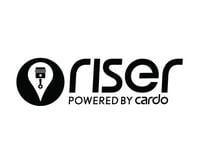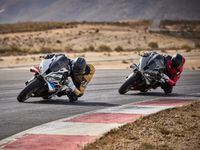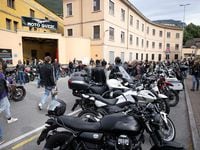It's been a while since we last rode an electric motorcycle, and the excitement has died down from a few years ago when they were all the rage. So when we were given the opportunity to ride American electric motorcycle manufacturer Zero Motorcycles' sporty SR model for a few weeks, we gladly grabbed the keys.
The Zero SR sports the company’s Z-Force 75-7R IPM (Interior Permanent Magnet) air-cooled, three-phase, brushless motor that pumps out a claimed 70 hp and 116 foot-pounds of torque, with the Z-Force 13.0 kWh Li-ion Power Pack battery pack holding enough juice to go a claimed 161 miles in city riding, or 101 miles on the highway at 70 mph. All power is direct drive from the motor (no transmission), and in the Zero SR’s case, through a carbon-fiber-reinforced belt drive.
The Zero's chassis is an aluminum twin-spar frame utilizing a fully adjustable 41mm Showa inverted fork and a fully adjustable Showa piggyback reservoir-equipped shock out back. A single J-Juan asymmetric dual-piston sliding caliper grabs a 320mm front disc, with a single-piston J-Juan caliper and 240mm disc brake in the rear, both utilizing a Bosch Gen 9 ABS. Wheel/tire sizes are geared toward low rolling resistance, with the 3.00-inch front and 3.50-inch-wide rear wheel shod with a 110/70-17 and 140/70-17 Pirelli Diablo Rosso II, respectively.
Settling into the Zero SR’s saddle reveals a fairly low seat height (specs say 31.8 inches, but it feels more like 30.8) and very narrow midsection. Overall ergos are comfortable but a bit confining with very little room to move forward or backward on the scalloped seat. The blue-hued LCD instrument panel is easily readable with important info organized well.
There are three ride modes: Eco, Sport, and Custom. Eco mode caps top speed at 70 mph, reduces power to conserve energy, and sets the engine regeneration levels higher. Sport mode gives you full power and minimal regen settings, while Custom mode allows you to tailor the power and regen settings to your liking via a smartphone app.
We also tested two optional accessories: the Z Force 3.3 kWh Power Tank that extends the bike’s range, and the Charge Tank, which allows the use of public EV charging stations to charge the battery three times quicker than the normal six to 10 hours using the standard onboard charger and any 120-volt outlet. Unfortunately, you must choose between the two, as they both mount in the same space behind the frame’s steering head.
While riding in Eco mode was expectedly lethargic, Sport mode unleashes enough torque to provide acceleration from around 15 mph to 80 mph that few gasoline-powered bikes can match (the downside is that using that power drains the battery quicker). The SR doesn’t seem overly hefty on paper at around 460 pounds, but you can feel that weight when riding the bike aggressively; overall handling manners are a little on the truckish side (a little more so with the Power Tank) despite the 55.5-inch wheelbase and steep steering geometry, and you can sense that the brakes are working hard to slow that weight.
During a 60-mile commute to/from work (consisting of about 10/90 street/highway riding), the Zero would usually arrive with between 12 and 25 percent battery charge remaining, depending on traffic—and that was riding very conservatively with the Power Tank option. The less highway running we did, the more energy we conserved; the problem is that extended the overall trip time by a significant amount.
In Los Angeles, there are literally hundreds of public EV charging stations, and you can find them with various phone apps. While it sounds on paper like it would be great to take a coffee break somewhere and quickly top up the battery, what we often discovered is that either the stations were all taken up by other EVs or the station would be out of order.
As a short-hop commuter bike, the Zero SR could be good fun, especially if recharge time isn’t mission-critical. But the starting MSRP of $15,995 is a bit pricey, and until the EV charging infrastructure grows significantly, it’s a rather limited application.













/cloudfront-us-east-1.images.arcpublishing.com/octane/YMWAIPIPSJAOXOU3QMJMGH37OM.jpg)


/cloudfront-us-east-1.images.arcpublishing.com/octane/EJ6KZRGAYBCVXNL2PJXL37UVWQ.jpg)
/cloudfront-us-east-1.images.arcpublishing.com/octane/AAN4TI76M5H5JMUVEIGASWXBDU.jpg)
/cloudfront-us-east-1.images.arcpublishing.com/octane/P3RXD2UCPFF37CMB7CHPVKXORY.jpg)
/cloudfront-us-east-1.images.arcpublishing.com/octane/VZEG2EJI2RDFZNHLRZMU56MD3Q.jpg)
/cloudfront-us-east-1.images.arcpublishing.com/octane/GVJQO5FFOFBWNGODOBRB4FBAW4.jpg)
/cloudfront-us-east-1.images.arcpublishing.com/octane/BIVAK2SFIBDJJM25E7I5VU2FJE.jpg)
/cloudfront-us-east-1.images.arcpublishing.com/octane/CH5VX52UG5CFHOVH5A6UYEFWWA.jpg)
/cloudfront-us-east-1.images.arcpublishing.com/octane/ZVGJNGZRU5C33N7KN23BBFKSC4.jpg)


/cloudfront-us-east-1.images.arcpublishing.com/octane/CZ5OM3E43ZEXJHY7LCYXCHLIKI.jpg)
/cloudfront-us-east-1.images.arcpublishing.com/octane/DF5T4K5KPZFJXFCTGPYR77PKJM.jpg)
/cloudfront-us-east-1.images.arcpublishing.com/octane/RMCT2KVQBJHBZMRTSLOVPMOILU.jpg)

/cloudfront-us-east-1.images.arcpublishing.com/octane/K45KB2XHQVA65DX7VN4ZSMT2BI.jpg)
/cloudfront-us-east-1.images.arcpublishing.com/octane/FNHXQQ56BRD7TO4YIJ453PNG2M.jpg)
/cloudfront-us-east-1.images.arcpublishing.com/octane/OIKJC4JA3ZH7BMKUGWYKBIY5FA.jpg)
/cloudfront-us-east-1.images.arcpublishing.com/octane/MT2SAEWY6FDXFBYSLDE3AEFDTM.jpg)
/cloudfront-us-east-1.images.arcpublishing.com/octane/66UPKPYVURBPRCP5HXSN56MEMM.jpg)
/cloudfront-us-east-1.images.arcpublishing.com/octane/EOREGDSRKFDCRJC6K3EDVHBGCE.jpg)
/cloudfront-us-east-1.images.arcpublishing.com/octane/42RF63Q3LVCMBP3DGTWXFYSMOA.jpg)